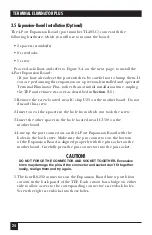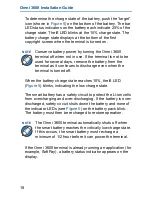
38
TERMINAL ELIMINATOR PLUS
when the TEP recognizes the “NNNN” command to return to Concentrate
mode. The “C2” will change the mode from Concentrate to Conversation with
slave port 2. Then the X-ON will allow the TEP to transmit slave 2’s data to
the master device. If you’re using the X-ON/poll flow-control method (see
Section 5.6
), you can omit the [X-OFF] code from the chained-command
string if you are starting from Conversation Mode (
not
Transparent
Conversation Mode) and you wait until you receive the end of a valid record
before sending the chained command string.
5.3 The Data-Direction Modes in Detail
The Terminal Eliminator Plus’s five data-direction modes are described in
Section 2.1
. Here are more details.
5.3.1 A
CCESSING THE
M
ODES
• To get to Concentrate Only Mode, position 2 of system switch SWF must
be OFF. If it is, the TEP will go to this mode when a user (a) first plugs in
the unit, (b) resets the unit, or (c) exits Broadcast Only Mode or either
Conversation mode by issuing the “Disconnect” or “Abort” command
string (see
Sections 5.2.1 and 5.2.2
) from the master device.
• To get to Concentrate and Broadcast Mode, position 2 of system switch
SWF must be ON. If it is, the TEP will go to this mode when a user (a)
first plugs in the unit, (b) resets the unit, or (c) exits Broadcast Only
Mode or either Conversation mode by issuing the “Disconnect” or “Abort”
command string (see
Sections 5.2.1 and 5.2.2
) from the master device.
• To get to Conversation Mode, a user must enter the “Conversation”
command string (see
Section 5.2.3
) from the master device when the TEP
is in either Concentrate mode.
• To get to Transparent Conversation Mode, a user must enter the
“Transparent” command string (see
Section 5.2.4
) from the master device
when the TEP is in either Concentrate mode.
• To get to Broadcast Only Mode, a user must enter the “Broadcast”
command string (see
Section 5.2.5
) from the master device when the TEP
is in either Concentrate mode.
















































